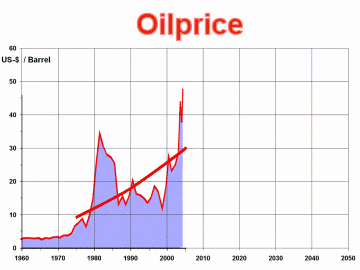| The
End of Cheap Energy
Oil price behaviour in the past
Fig. 1 shows the development of crude oil prices
between 1960 and 2005. It is characterised by considerable fluctuations
with an underlying evident upward trend. This trend is reflected
in the plotted average-value curve. “It cannot be what must
not be” is an approach most of the influential forces seem
to have agreed upon for quite some time. High energy prices are
not exactly a stimulus for the economy. That is why this possibility
had to be eliminated right from the start. It is easy to see that
reality developed differently to this wishful thinking. It would
have been less hard on all of us if economy and society had been
seriously prepared for high energy prices.
Oil prices will still dominate the
level of prices for a long time
Today, crude oil is the main energy source of a worldwide hunger
for energy. According to studies of the International Energy Agency
[IEA 2001], it is crude oil that will dominant energy prices for
a long time to come.
Determining factors for oil prices
Naturally, oil prices may decline within the next year. It is one
characteristic of such markets that are being ruled by speculations
to be almost unpredictable. One more reason to reduce dependency
a little?
But let us discuss the development once again in relation to the
main reasons causing presently high energy prices:
- Oil production capacities in
Europe and Northern America are decreasing.
Fewer capacities – this trend will itensify
in the future.
- Yukos ( Russia), Acts of Sabotage
and Terror in Iraq
Is it just a “current problem”? Who is making statements
concerning future security?
- Increasing Energy Demand in China
And China’s increased demand for energy is only the beginning.
This is the main middle- and long-term driving force.
- 4 Hurricanes within 6 Weeks (
in 2004)
For the time being just a current problem, but henceforth a major
one due to climatic changes; that has been proven in 2005 again.
- OPEC Capacity Limits
a medium-term solution seems possible, but in the long run capacity
limits exist everywhere, cp. „peak oil“.

Fig. 1: Oil price development in the past- and in the future
Conclusion for the Future
Level of Energy Prices (cp. Fig.1)
We dare to estimate an extrapolation of medium energy
prices. No forecast, mind you, but a well-founded extrapolation
based on the previous given analysis. There will not be an exponential
rise in energy prices – substitution potentials are preventing
this development. But future medium energy prices will hardly be
lower then today’s daily prices in the relevant period of
time. That is the period, in which new or modernised buildings require
a certain amount of heat energy.
Interestingly enough, economic experts have agreed upon this conclusion
again. It was known that a rise in prices had to take place at some
stage, but the exact date was hardly predictable. Current prices,
slightly exceeding the trend, may by all means drop again –
a possibility allready taken into account in the trendline.
What kind of energy prices are to be expected? With a medium oil
price level of about 55 Cent per litre, heat prices will derive
at 6,1 Cent per kWh, using an annual combustion efficiency of 90%.
Adding the expenses for auxiliary power (appr. 0,3 Cent/kWh) and
the variable share of system costs, medium future heat prices are
assumed to be about 8 Cent/kWh.
Thereby not yet including expenses for CO2 mitigation.
What Can be Done?
Prospects would not be very good, if we continued to be dependant
on energy imports of constant quantities on the world market. Fortunately,
we are not dependant any longer: native energy substitution is available
– on a competitive basis even compared to today’s energy
prices (biomass energy, wind- and water power for heat pumps). Unfortunately,
these energy sources are available on a limited scale. But that
is not necessarily a problem as it is possible to reduce the energy
demand by a factor
4 (and even more) with improved energy efficiency.Against the
background of future energy prices this is economically advantageous.
The Passive
House is one example of a highly energy efficient solution.
Compared to conventional buildings, Passive Houses demand slightly
higher investment costs. It is thus imortant to have an elaborate
financing. Working groups no. III, IV and XIV at the Conference
on Passive Houses will deal with the question of ”Promoting
Passive Houses”.
Literature
[IEA 2001] International Energie Agency: World Energy
Outlook; IEA-Press, 1. edition, Oct. 2001
(Author: Dr. Wolfgang Feist)
You
want to submit a paper? Find more
Information
here.
Time
schedule of the 10th International Conference on Passive Houses
in Hannover
2005 Dezember 1st:
Deadline for abstracts
2006 February 1st: Notification on acceptance
of abstracts
2006 March 1st: Registration
period for reduced fee ends
2006 March 15th: Deadline for
the written contributions of the preceedings
2006 May 19th
and 20th 10. Conference on Passive Houses HCC Hannover
with Exhibition
on Passive House Components and
manufacturers
session
May 21st
field trip to the most interesting Passive House projects and construction
sites incl. refurbishment in the region near Hannover.
(updated:2005-10-14 ©
Passive House Institute PHI; this page might be reprinted if unchanged)
The PHI is
not responsible for the content of linked web-pages.
Passive
House Institute, Dr. Wolfgang Feist. mail@passiv.de.
|

 PDF 248 kb
PDF 248 kb